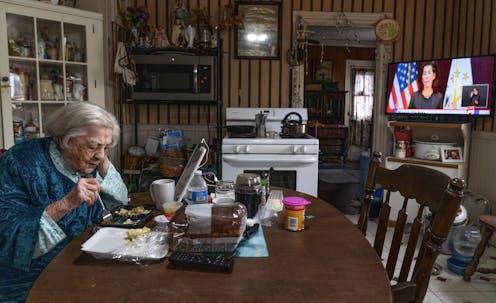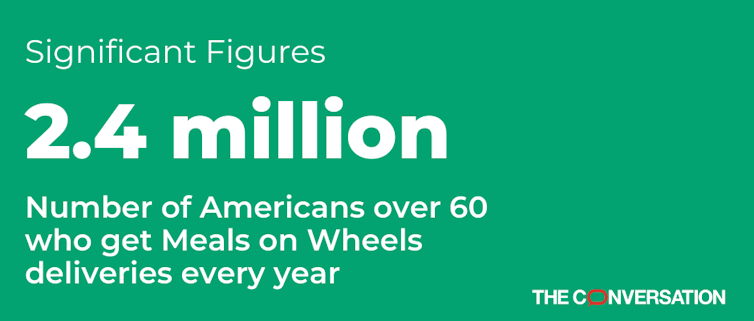Meals on Wheels volunteers help 2.4 million US seniors get enough to eat while staving off lonelines
Personal interactions between volunteers and the older adults they assist, which paused due to pandemic concerns, are resuming.


More than 2.4 million older adults are supported each year by Meals on Wheels, a program through which seniors and people with disabilities receive healthy and tasty meals for free from a network of volunteers. These efforts are usually organized through local senior centers and other community organizations across the U.S. that encourage the people who receive meals to make voluntary donations to cover at least part of the cost if that’s within their means.
Services like this nonprofit meal delivery program, for which eligibility begins at age 60, are becoming more important than ever before. About 5.3 million people 60 and up, 7.3% of all Americans in that age group, experienced food insecurity in 2018 – meaning that their households couldn’t acquire adequate food because they lacked enough money and other resources.
What’s more, the U.S. population is aging. The number of Americans who are 65 and up grew by one-third over the past decade, to 54 million people.
And, a growing share of the 1 in 6 Americans who are in that demographic group wish to age in place. That is, regardless of how ill or frail they are, they want to stay in their own homes, instead of going to a nursing home or assisted living facility.
No matter where folks live as they age, ailments and physical challenges will almost surely crop up. Those health problems will make getting out and about more difficult, and it will be increasingly hard for them to shop for food, cook meals and even feed themselves.
Daily Meals on Wheels deliveries also make a difference in ways unrelated to nutrition. According to gerontology and health services research Kali Thomas conducted and Meals on Wheels America commissioned, seniors who got hot meals delivered became less concerned about being able to continue living in their own homes. They also felt less isolated and lonely compared to those who received frozen meals, delivered once a week in bulk, or people who received none at all.
Despite those findings, as the COVID-19 pandemic set in, Meals on Wheels volunteers made needed adjustments. They began to drop off more meals at a time, sometimes in multi-week bundles. Rather than speaking with the people receiving food and companionship in person, some agency volunteers made phone calls to connect with them.
In some parts of the country, such as Rowan, North Carolina and Longmont, Colorado, Meals on Wheels saw demand for its deliveries rise. This probably occurred because even older adults who are able to do their own errands were newly homebound due to concerns about the coronavirus, which disproportionately kills elderly people.
With the majority of older adults in the U.S. now vaccinated against COVID-19, Meals on Wheels volunteers are resuming their traditional social contact. Often, volunteer visits are the only in-person interaction a program participant will have that day.
In my view, this is welcome news.
[You’re smart and curious about the world. So are The Conversation’s authors and editors. You can read us daily by subscribing to our newsletter.]
David R. Buys receives funding from the United States Department of Agriculture, the Substance Use and Mental Health Services Administration, the Centers for Disease Control and Prevention, and the National Institutes of Health.
Read These Next
How the NIH became the backbone of American medical research and a major driver of innovation and ec
The agency’s budget has grown steadily since the 1960s, fueling an industry that creates lifesaving…
What’s at stake in Trump’s executive order aiming to curb state-level AI regulation
In the absence of comprehensive federal AI regulation, states have stepped in. The Trump administration,…
Data centers need electricity fast, but utilities need years to build power plants – who should pay?
How many data centers will be built – and how much electricity they’ll need – is uncertain. Being…





